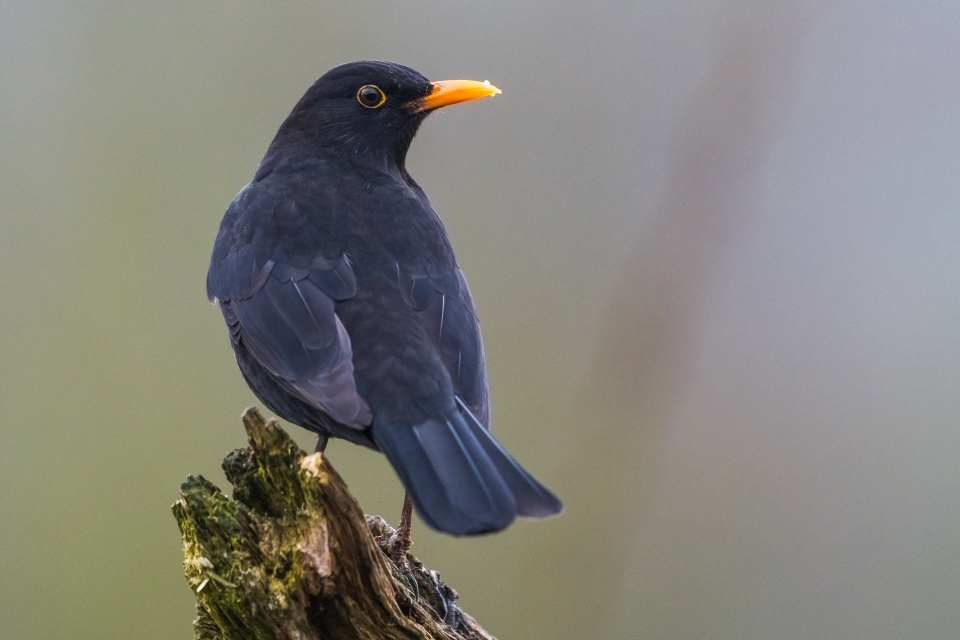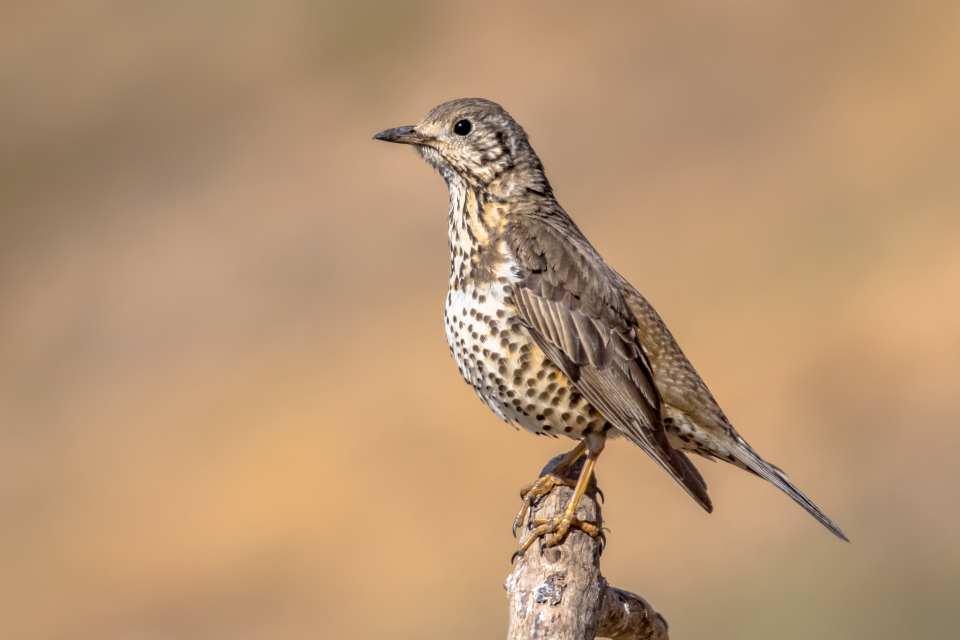Species Guide: Mistle Thrush (Turdus viscivorus)
Family: Turdidae
The Mistle Thrush is a large, long-winged member of the thrush family (Turdidae) found across much of Europe, parts of temperate Asia, and North Africa. It is often noticeable, perched high in a tree, delivering a loud, far-carrying song, and is well known for eating and dispersing sticky berries, such as those of mistletoe. Globally, the species is currently assessed as Least Concern by the IUCN, though regional declines have been recorded in parts of its range.
Appearance
Male & Female
Males and females have similar plumage. Adults are relatively large for thrushes, with grey-brown upperparts, a paler greyish-white throat and chin, and a strongly spotted breast and flanks. The rounded, widely spaced spots distinguish them from Song Thrushes. They often appear upright and bold when perched. Their flight reveals long wings and a tail with pale edges.

Juvenile
Juveniles resemble adults but are paler above with creamy feather centres and smaller, more diffuse underpart spots. By their first winter, most juveniles closely match adults, though underparts may be more buff-toned.

Diet
Mistle Thrushes have an omnivorous diet that changes seasonally. In spring and summer, they feed largely on invertebrates, earthworms, beetles, snails, slugs, and other insects; they forage from the ground or short grass. In autumn and winter, they switch to fruit and berries (rowan, hawthorn, yew, holly, and mistletoe), and will defend berry-rich trees from other birds to protect the food supply. They are effective seed dispersers for plants such as mistletoe, which benefit from the bird’s habit of wiping sticky berry residues on bark and passing seeds in droppings.
Habitat
Mistle thrushes use a range of habitats: open woodland, parkland, hedgerows, pasture, scrub, orchards, and town parks and gardens. They prefer landscapes with scattered trees and open ground for foraging and will breed in both rural and suburban settings. Northern and eastern populations may migrate south in winter, often gathering in small flocks.

Summer
Resident
Winter
Behavior
General behavior
Mistle thrushes are bold and conspicuous, often perching on exposed branches or posts to sing. They are territorial around food trees in winter and may chase other birds from berry sources, foraging on the ground with purposeful hops and bounds.
Call & song
The song is loud, clear, and far-carrying, often delivered from an exposed perch and audible in poor weather (which earned the species the old name “stormcock”). Alarm or flight calls include a rattling, harsher note used when disturbed. Recordings and spectrograms show phrases that are flute-like but harsher and more rattling than many smaller thrush songs.
Life cycle
Fledging & juvenile care: Chicks fledge at ~14–16 days and remain dependent on parents for a further 2–3 weeks. Juvenile first-year survival and adult annual survival rates vary by location; life expectancy is typically a few years, though some individuals have been recorded living 20+ years.
Breeding season: Typically two broods per year in much of the range (one brood in the far north).
Nest and eggs: The clutch size is usually 3–5 eggs (range 2–6); eggs are pale with reddish/brown spotting and average ~30 × 22 mm. Incubation lasts about 12–15 days and is mainly by the female.

Biometrics
| Body Length | 27 cm |
| Wing Length | 42-48 cm |
| Body Weight | 100-150 grams |
| Longevity | 3 Years |
Natural Predators
Predators include a range of raptors (e.g., sparrowhawk, goshawk, buzzards, owls) that can take adults, while eggs and chicks are vulnerable to corvids (crows, magpies), and mammalian predators such as foxes and domestic/feral cats. Nests are strongly defended by parent birds, which may aggressively mob intruders. Parasites (external and internal) can also affect the species.
Relationship to Humans (including fables)
The Mistle Thrush has a long cultural history in Europe. It is linked to mistletoe both biologically (seed dispersal) and culturally; older proverbs and writings note its association with sticky mistletoe berries and birdlime (an ancient trapping material). Poets and writers (e.g., Thomas Hardy’s Darkling Thrush, Edward Thomas) have used the bird’s distinctive song as literary imagery. In folklore, the bird’s habit of defending berry trees and being active in winter made it a recognizable symbol of resilience and the winter landscape.
Conservation Status (including trends)
- Global status: Listed as Least Concern by the IUCN because of its very large range and large global population.
- Population trends: Although globally numerous, the species has suffered regional declines in places. For example, long-term monitoring in the UK shows substantial declines since the 1970s (it was added to the UK Red List of Conservation Concern in 2015), and some European studies report moderate declines in parts of its range. Suggested causes for local declines include agricultural intensification (loss of mixed pasture and invertebrate-rich habitats), changes in forestry, and landscape management that reduces breeding and foraging quality. That said, trends vary regionally; some populations are stable while others are decreasing.
Conservation actions & what helps
Maintaining mixed farmland, pasture with abundant invertebrate prey, hedgerows, scattered trees, and berry-bearing shrubs helps the species. Protecting and restoring low-intensity grazing pastures and woodland edges, and retaining fruit-bearing trees and hedgerow diversity in agricultural and urban landscapes, support mistle thrush populations. Monitoring through national bird surveys continues to inform conservation priorities.
U.K.
Conservation Status

Global
Conservation Status

Ad Space
Related Articles



CITATIONS
- By IUCN Red List of Threatened Species, species assessors and the authors of the spatial data., CC BY-SA 3.0, [Accessed 15/10/2025] ↩︎
References
Lovette, I. et al. (2016) The Cornell Lab of Ornithology, handbook of bird biology. Third edition. Chichester: Wiley. [Accessed 15/10/2025]







